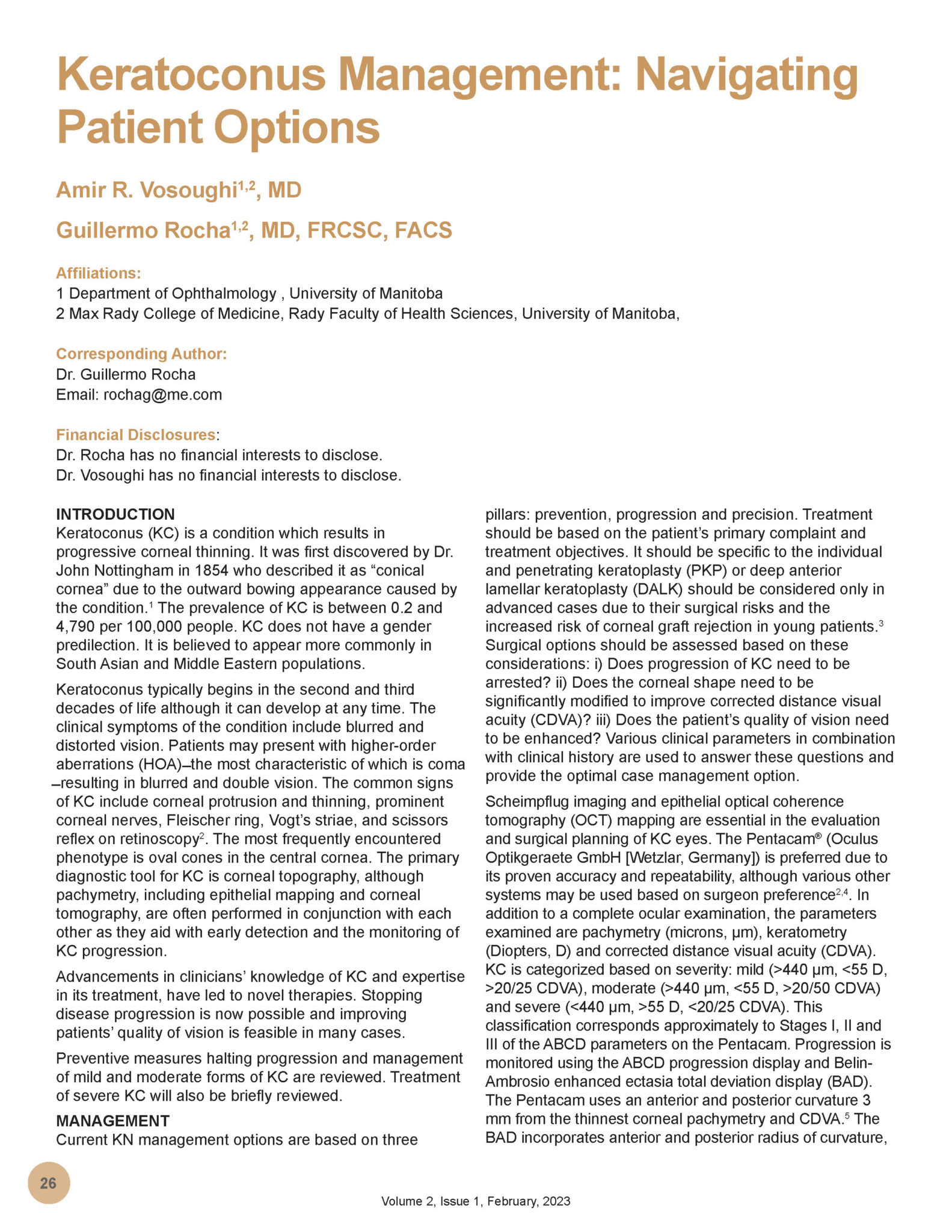Keratoconus Management: Navigating Patient Options
DOI:
https://doi.org/10.58931/cect.2023.2123Abstract
Keratoconus (KC) is a condition which results in progressive corneal thinning. It was first discovered by Dr. John Nottingham in 1854 who described it as “conical cornea” due to the outward bowing appearance caused by the condition. The prevalence of KC is between 0.2 and 4,790 per 100,000 people. KC does not have a gender predilection. It is believed to appear more commonly in South Asian and Middle Eastern populations.
Keratoconus typically begins in the second and third decades of life although it can develop at any time. The clinical symptoms of the condition include blurred and distorted vision. Patients may present with higher-order aberrations (HOA) ̶ the most characteristic of which is coma ̶ resulting in blurred and double vision. The common signs of KC include corneal protrusion and thinning, prominent corneal nerves, Fleischer ring, Vogt’s striae, and scissors reflex on retinoscopy. The most frequently encountered phenotype is oval cones in the central cornea. The primary diagnostic tool for KC is corneal topography, although pachymetry, including epithelial mapping and corneal tomography, are often performed in conjunction with each other as they aid with early detection and the monitoring of KC progression.
Advancements in clinicians’ knowledge of KC and expertise in its treatment, have led to novel therapies. Stopping disease progression is now possible and improving patients’ quality of vision is feasible in many cases.
Preventive measures halting progression and management of mild and moderate forms of KC are reviewed. Treatment of severe KC will also be briefly reviewed.
References
Gokul A, Patel DV, McGhee CNJ. Dr. John Nottingham’s 1854 landmark treatise on conical cornea considered in the context of the current knowledge of keratoconus. Cornea. 2016;35(5):673-678. DOI: https://doi.org/10.1097/ICO.0000000000000801
Santodomingo-Rubido J, Carracedo G, Suzaki A, Villa-Collar C, Vincent SJ, Wolffsohn JS. Keratoconus: An updated review. Cont Lens Anterior Eye. 2022;45(3):101559. DOI: https://doi.org/10.1016/j.clae.2021.101559
Wajnsztajn D, Hopkinson CL, Larkin DFP. National Health Service Blood and Transplant Ocular Tissue Advisory Group and contributing ophthalmologists (OTAG Study 29). Keratoplasty for keratoconus in young patients: demographics, clinical features, and post-transplant outcomes. Am J Ophthalmol. 2021;226:68-75. DOI: https://doi.org/10.1016/j.ajo.2021.02.003
Hashemi H, Beiranvand A, Yekta A, Maleki A, Yazdani N, Khabazkhoob M. Pentacam top indices for diagnosing subclinical and definite keratoconus. J Curr Ophthalmol. 2016;28(1):21-26. DOI: https://doi.org/10.1016/j.joco.2016.01.009
Belin MW, Duncan JK. Keratoconus: the ABCD grading system. Klin Monbl Augenheilkd. 2016;233(06):701-707. DOI: https://doi.org/10.1055/s-0042-100626
Martinez-Abad A, Piñero D. New perspectives on the detection and progression of keratoconus. J Catarac Refract Surg. 2017;43(9):1213-1227. DOI: https://doi.org/10.1016/j.jcrs.2017.07.021
Pellegrini M, Bernabei F, Friehmann A, Giannaccare G. Obstructive sleep apnea and keratoconus: a systematic review and meta-analysis. Optom Vis Sci. 2020 Jan;97(1):9-14. doi:10.1097/OPX.0000000000001467 DOI: https://doi.org/10.1097/OPX.0000000000001467
Hashemi H, Heydarian S, Hooshmand E, Saatchi M, Yekta A, Aghamirsalim A, et al. The prevalence and risk factors for keratoconus: a systematic review and meta-analysis. Cornea. 2020;39(2):263-270. DOI: https://doi.org/10.1097/ICO.0000000000002150
Sorkin N, Varssano D. Corneal collagen crosslinking: a systematic review. Ophthalmologica. 2014;232(1):10-27. doi:10.1159/000357979 DOI: https://doi.org/10.1159/000357979
Hersh PS, Stulting RD, Muller D, Durrie DS, Rajpal RK, U.S. Crosslinking Study Group. U.S. multicenter clinical trial of corneal collagen crosslinking for treatment of corneal ectasia after refractive surgery. Ophthalmology. 2017;124(10):1475-1484. DOI: https://doi.org/10.1016/j.ophtha.2017.05.036
Greenstein SA, Fry KL, Hersh MJ, Hersh PS. Higher-order aberrations after corneal collagen crosslinking for keratoconus and corneal ectasia. J Cataract Refract Surg. 2012;38(2):292-302. DOI: https://doi.org/10.1016/j.jcrs.2011.08.041
Muzychuk A, Penner V, Rocha G. High order aberration outcomes of corneal collagen crosslinking in eyes with keratoconus and post-LASIK ectasia. Int J Keratoconus Ectatic Corneal Dis. 2014;3(3):107-112. DOI: https://doi.org/10.5005/jp-journals-10025-1088
Muzychuk A, Penner V, Rocha G, Al-Ghoul A. The effects of epithelium-off corneal collagen cross-linking on peripheral corneal keratometry, pachymetry as well as Scheimpflug imaging calculated corneal indices in keratoconus. Int J Keratoconus Ectatic Corneal Dis. 2014;3(3):113-117. DOI: https://doi.org/10.5005/jp-journals-10025-1089
Zhu AY, Jun AS, Soiberman US. Combined protocols for corneal collagen cross-linking with photorefractive surgery for refractive management of keratoconus: update on techniques and review of literature. Ophthalmol Ther. 2019;8(1):15-31. DOI: https://doi.org/10.1007/s40123-019-00210-3
Hafezi F, Kling S, Gilardoni F, et al. Individualized corneal cross-linking with riboflavin and UV-A in ultrathin corneas: the Sub400 Protocol. Am J Ophthalmol. 2021;224:133-142. DOI: https://doi.org/10.1016/j.ajo.2020.12.011
Rocha G, Ibrahim T, Gulliver E, Lewis K. Combined phototherapeutic keratectomy, intracorneal ring segment implantation, and corneal collagen cross-linking in keratoconus management. Cornea. 2019;38(10):1233-1238. DOI: https://doi.org/10.1097/ICO.0000000000002073
Ang M, Mehta JS. Deep anterior lamellar keratoplasty as an alternative to penetrating keratoplasty. Ophthalmology. 2011;118(11):2306-2307. DOI: https://doi.org/10.1016/j.ophtha.2011.07.025
Dragnea DC, Birbal RS, Ham L, Dapena I, Oellerish S, van Dijk K. Bowman layer transplantation in the treatment of keratoconus. Eye Vis (Lond). 2018 Sep 12;5:24. doi:10.1186/s40662-018-0117-y DOI: https://doi.org/10.1186/s40662-018-0117-y
El Zarif M, Alió del Barrio J L, Arnalich-Montiel F, De Miguel MP, Makdissy N, Alió JL. Corneal stroma regeneration: new approach for the treatment of cornea disease. Asia-Pac J Ophthal. 2020;9(6):571-579. DOI: https://doi.org/10.1097/APO.0000000000000337
Jacob S, Patel SR, Agarwal A, Ramalingam A, Saijimol AI, Raj JM. Corneal allogenic intrastromal ring segments (CAIRS) combined with corneal cross-linking for keratoconus. J Refract Surg. 2018;34(5):296-303. DOI: https://doi.org/10.3928/1081597X-20180223-01

Published
How to Cite
Issue
Section
License

This work is licensed under a Creative Commons Attribution-NonCommercial-NoDerivatives 4.0 International License.
